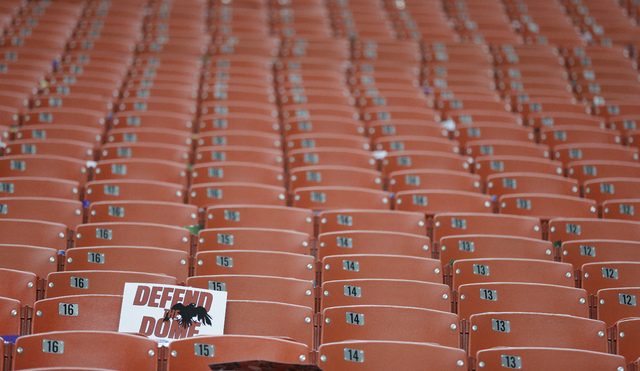NFL fights falling attendance, even as TV ratings soar

PITTSBURGH — Mike Tomlin isn’t much on public gratitude. Still, the perpetually focused Pittsburgh Steelers coach went out of his way to thank the fans who showed up at Heinz Field to watch his team drum the Buffalo Bills 23-10 on Sunday for its third win of the season.
“It’s not something we take for granted,” Tomlin said.
Good idea.
A crowd of 60,406 turned out to watch two teams with a combined 5-12 record play on a cold, blustery day more suited for late December than three weeks before Thanksgiving. The 5,000 or so who bought their tickets but chose to not make it through the turnstiles were conspicuous, their absence marked by pockets of open gold seats in certain portions of the stadium tucked tight against the Allegheny River.
Welcome to life in the new NFL, where “sellouts” are the norm but full houses are becoming the exception, and not just in places like woeful Jacksonville.
Blame it on mediocre teams. Blame it on rising ticket prices. Blame in on the comfort of your couch, where it doesn’t cost hundreds of dollars to sit, and the cold beer in your fridge, the one that doesn’t cost $8 a bottle.
The Steelers (3-6), who have six Vince Lombardi Trophies in the lobby at team headquarters, are in danger of posting their lowest average attendance since 2003, when they limped to a 6-10 record and missed the playoffs.
The franchise is on a similar trajectory this fall in a place that can be tough — by NFL standards — to completely fill even when times are good. Pittsburgh is averaging 61,465 through four home dates, the lowest over the same span since Heinz Field opened in 2001.
It’s a trend hitting the league regardless of market size or on-field success. In 2008, only five teams played to stadiums less than 95 percent full. That number has doubled this season at a time when TV ratings are at their best since 2006.
The Washington Redskins have one of the NFL’s rising stars in quarterback Robert Griffin III and are playing to just 88.9 percent capacity this season. The surprising New York Jets have the nation’s largest metropolitan area to pull from, and only 93.3 of those with tickets are showing up.
Then again, New York can be a tough market.
Steelers wide receiver Jerricho Cotchery was on the 2007 Jets that staggered to a 4-12 record. As the season wore on and the losses mounted, things got weird.
“Pittsburgh came to town, but it felt like an away game,” Cotchery said. “It was so loud in there. I remember us doing silent count and all of that stuff at home. But we were a bad team. I probably wouldn’t want to take my kid out in the cold and watch a bad team play football.”
It can lead, in some instances, to the unnerving realization that players can’t simply rely on the juice — or the vitriol — from the crowd to get amped up.
“When we play on the road, certain places are just known for being quiet,” Cincinnati left tackle Andrew Whitworth said. “It’s almost like in the huddle, you have to keep reminding yourself to keep your energy up and realize that some of these places are really quiet and you have to create your own energy a little bit.”
The NFL amended its TV blackout rule last year, allowing teams to sell only 85 percent of its prime tickets to meet the threshold necessary to have home games broadcast locally. While the decision has done nothing but goose TV ratings even further, getting folks into the stadium on a regular basis in some cities remains a tough task.
Oakland and Jacksonville swath their stadiums in massive drapes that cover entire sections. While the atmosphere has improved with the Raiders, only 81.4 percent of ticket holders make it to their seats. More than 10 percent of those with tickets in Jacksonville don’t bother to get an eyeful of one of the league’s worst teams.
Commissioner Roger Goodell continues to stress the in-game fan experience remains important to the league. It also remains important to the bottom lines of owners, if only to fatten their wallets.